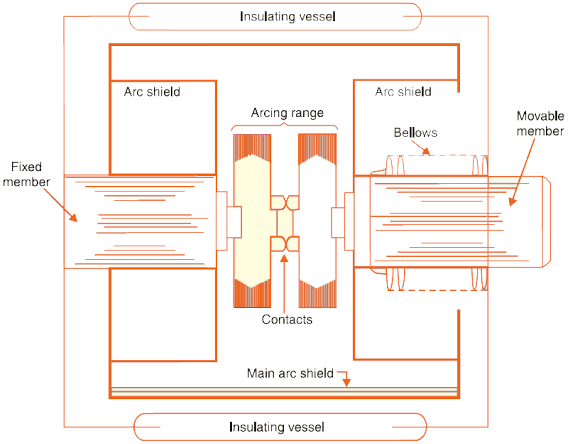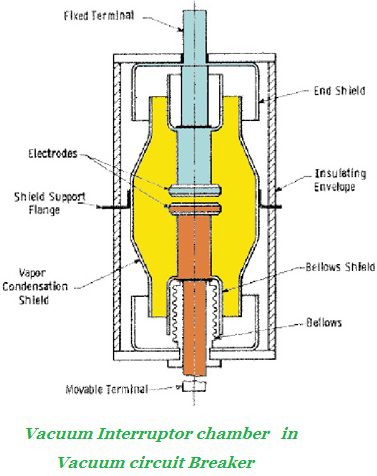Vacuum Circuit Breakers(VCB):
In Vacuum Circuit Breakers, vacuum (degree of vacuum being in the range from 10 – 7 to 10 – 5 torr) is used as the arc quenching medium. Since vacuum offers the highest insulating strength, it has far superior arc quenching properties than any other medium. For example, when contacts of a breaker are opened in vacuum, the interruption occurs at first current zero with dielectric strength between the contacts building up at a rate thousands of times higher than that obtained with other circuit breakers.
Principle of Vacuum Circuit Breakers:
The production of arc in a vacuum circuit breaker and its extinction can be explained as follows :
When the contacts of the breaker are opened in vacuum (10−7 to 10−5 torr), an arc is produced between the contacts by the ionisation of metal vapours of contacts. However, the arc is quickly extinguished because the metallic vapours, electrons and ions produced during arc rapidly condense on the surfaces of the circuit breaker contacts, resulting in quick recovery of dielectric strength.
The reader may note the salient feature of vacuum as an arc quenching medium. As soon as the arc is produced in vacuum, it is quickly extinguished due to the fast rate of recovery of dielectric strength in vacuum.
Construction of Vacuum Circuit Breakers:
The figure below shows the construction of vacuum circuit breaker. It consists of fixed contact, moving contact and arc shield mounted inside a vacuum chamber. The movable member is connected to the control mechanism by stainless steel bellows. This enables the permanent sealing of the vacuum chamber so as to eliminate the possibility of leak.
A glass vessel or ceramic vessel is used as the outer insulating body. The arc shield prevents the deterioration of the internal dielectric strength by preventing metallic vapours falling on the inside surface of the outer insulating cover.

Working of Vacuum Circuit Breakers:
This is working of vacuum circuit breakers.When the breaker operates, the moving contact separates from the fixed contact and an arc is struck between the contacts.The production of arc is due to the ionisation of metal ions and depends very much upon the material of contacts.
The arc is quickly extinguished because the metallic vapours, electrons and ions produced during arc are diffused in a short time and seized by the surfaces of moving and fixed members and shields. Since vacuum has very fast rate of recovery of dielectric strength, the arc extinction in a vacuum circuit breaker occurs with a short contact separation (say 0·625 cm).

Advantages of Vacuum Circuit Breakers:
Vacuum circuit breakers have the following advantages :
(i) They are compact, reliable and have longer life.
(ii) There are no fire hazards.
(iii) There is no generation of gas during and after operation.
(iv) They can interrupt any fault current. The outstanding feature of a VCB is that it can break any heavy fault current perfectly just before the contacts reach the definite open position.
(v) They require little maintenance and are quiet in operation.
(vi) They can successfully withstand lightning surges.
(vii) They have low arc energy.
(viii) They have low inertia and hence require smaller power for control mechanism.
Applications of Vacuum Circuit Breakers:
For a country like India, where distances are quite large and accessibility to remote areas difficult, the installation of such outdoor, maintenance free circuit breakers should prove a definite advantage. Vacuum circuit breakers are being employed for outdoor applications ranging from 22 kV to 66 kV. Even with the limited rating of say 60 to 100 MVA, they are suitable for a majority of applications in rural areas.